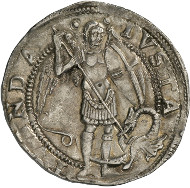Human faces, part 28: Fight for Sicily
courtesy of the MoneyMuseum, Zurich
translated by Teresa Teklic
Why was the human head the motif on coins for centuries, no, for millennia? And why did that change in the last 200 years? Ursula Kampmann is looking for answers to these questions in her book “Menschengesichter” (“Human faces”), from which the texts in this series are taken.
Ferdinand I of Aragón, King of Naples (1458-1494). Coronato, Naples. Armour-clad bust of Ferdinand with crown, turning to the right. Rv. Archangel Michael, slaying the dragon. © MoneyMuseum, Zurich.
Frederick II – not only Emperor of the Holy Roman Empire but also King of Sicily – died in 1250. The Pope claimed the right to decide who was to become the next king of Sicily for himself. After all, Sicily was a papal fief. He sold the land to an English prince for a sizeable sum of money. When the Pope did not get his money, however, he dumped the prince and made Charles of Anjou the new king of Sicily.
Anjou expressed his gratitude, paid the money and tried to cover the expense for Sicily with taxes from his subjects. Not a good idea: in 1282, the Sicilians chased the “invader” out and allied with the King of Aragón, who was now able to claim the throne because he had married Frederick’s II granddaughter. Charles of Anjou retreated to Naples. And during the next decades, Anjou and Aragón fought a bitter war in southern Italy. Naturally, the Pope supported the House of Anjou and banned Peter of Aragón and his descendants.
Manuel Aguirre y Monsalbe, fictitious portrait of Ferdinand I of Aragón made in the 19th cent. Source: Wikicommons.
Only in 1435 was Alfonso of Aragón able to win Naples. Instead of joining his new conquest to his numerous other territories, the smart king instituted his illegitimate son Ferdinand as king. That way, he secured Ferdinand’s rule over Naples when Alfonso died in 1458, although a jealous Pope kept insisting on his own candidates from the House of Anjou.
But Popes don’t live forever. Not even two months after Alfonso’s death, his enemy Calixtus III passed away and the papal successor, Pius II, was looking for a more diplomatic solution. On February 4, 1459, he sent Cardinal Sabino Orsini to coronate Ferdinand of Aragón. Which, by the way, didn’t mean that the Anjous had given up their claims, not at all. They continued to fight – until 1734.
Against this background, Ferdinand knew about the importance of propaganda and minted coins with the inscription “Coronated because confirmed as legitimate” (in translation). It was only when Ferdinand’s enemies were driven back – at least for the moment – that these words were replaced by the text on our coin. Now the royal title read: “FERRANDVS ARAGO(niae) REX SI(ciliae) HI(erosolymae),” which translated means as much as: „Ferdinand of Aragón, King of Sicily and Jerusalem“.
Sicily, which at the time designated Naples and its surrounding region, was to remain under the wise rule of Ferdinand until his death. Jerusalem, his other kingdom, which already his predecessor had claimed in vain, remained in the hands of the Arabs and Ferdinand was never to set foot in it.
In the next episode, we will travel further north, to Venice, and learn that, even in the Doge’s Palace, all that glitters is not gold …
You can find all episodes in the series here.
A German edition of the book “Menschengesichter” is available in print and as ebook on the site of the Conzett Verlag.











